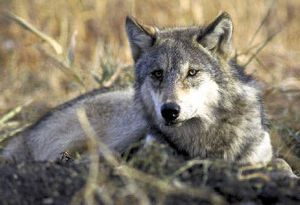Report: Idaho tallies at least 780 wolves in 108 packs across state
PREDATORS -- Idaho had a minimum of 108 wolf packs and at least 780 wolves at the end of 2015, accord to an annual report posted today.
That confirms the reintroduced predator species remains well above the 150 wolves and 15 breeding pairs required to keep gray wolves off the endangered species list under the 2009 de-listing rule, Idaho Fish and Game Department officials say.
Gray wolf numbers rose across most of the Northern Rockies last year, reaching their highest level since federal officials reintroduced the predators to the region two decades ago.
The U.S. Fish and Wildlife Service on Friday reported a minimum of 1,904 wolves at the end of last year in Idaho, Montana, Wyoming, Oregon and Washington.
Congress lifted protections for wolves across the region except for Wyoming in 2011.
Their numbers have continued to slowly climb as packs spread into new areas. That includes portions of Washington state and Oregon, which now have a minimum of 200 wolves combined.
In states that allow hunting of the species, wolf numbers dipped in Montana to 536 animals and rose slightly in Idaho to 786 wolves.
- See Idaho's 2015 annual summary of wolf monitoring.
- Montana's 2015 wolf report also was released today.
- Washington's 2015 wolf status report was released on March 14.
- Oregon's 2015 wolf update also was released in early March.
- Wyoming's 2015 report said wolf numbers were up 25 percent.
- Wolf status reports from all of the Northern Rockies states are compiled by the U.S. Fish and Wildlife Service.
The 2015 Idaho Wolf Monitoring Progress Report includes the current status of the wolf population in Idaho.
Biologists documented 108 wolf packs in Idaho at the end of 2015. In addition, to the 108 packs Idaho documented within its borders, documented packs counted by Montana, Wyoming, and Washington had established territories overlapping the Idaho state boundary.
Not all packs are presumed documented by the Idaho wolf surveys or any other state surveys.
An estimated 786 wolves were associated with documented packs of wolves in Idaho at the end of 2015, similar to that for 2014, yet below that of the peak years of 2008 and 2009.
Biologists made closer study of 53 packs to determine if they met the federal breeding pair criteria (an adult male and adult female and at least 2 pups present on December 31). Of these, biologists documented that 33 packs met breeding pair criteria at the end of 2015. Because the number of packs meeting breeding pair criteria was already well above the federal recovery requirement, Idaho did not undertake the considerable expense and personnel time necessary to confirm whether the remaining packs met federal breeding pair criteria.
Wolf harvest by hunters and trappers was unchanged from 2014 to 2015. Hunters and trappers harvested 256 wolves in 2015. Fifty four wolves were killed in response to depredations on livestock and 21 were taken to reduce predation on big game populations in 2015.
Average pack size was 6.4 wolves at the end of 2015, similar to the 6.5 average wolf pack size in 2014 and smaller than the 8.1 wolves per pack average during the 3 years prior to the establishment of harvest seasons in 2009.
Wolf depredations on livestock have trended downward since wolf harvest began in 2011. USDA Wildlife Services agents classified 35 cattle, 125 sheep, 3 dogs, and 1 horse as confirmed wolf depredations in 2015. Nine cattle and 9 sheep were classified as probable wolf depredations.
